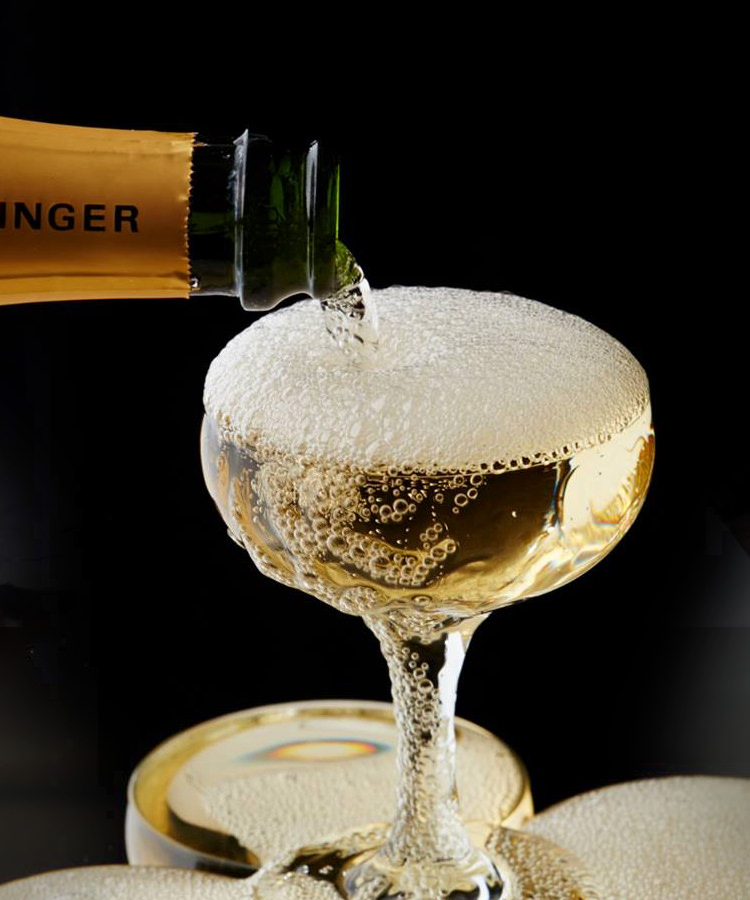The holidays are a time for celebration. Dishes, passed down from generations, are shared with family and friends, and wine — sipped or gulped — ushers in the New Year. For many, these celebrations wouldn’t be the same without glasses of Champagne, raised in honor of family traditions and new beginnings. But which Champagnes should we reach for when bottles of bubbly abound?
First, a little background: Sparkling wine can only be identified as “Champagne” (with a capital “c”) when it comes from the Champagne wine region in the northeast of France and is made according to strict Appellation d’Origine Controlée (AOC) regulations. While wine has been produced in the region since 496 A.D. — the work of monks in monasteries, said to have been used in the consecration of the first king of France in Reims Cathedral — its effervescence has only been fully appreciated since about the late 1600s. In fact, winemakers before that time were appalled to find fizz within their bottles, an unintended consequence of incomplete fermentation brought on by early frosts, followed by a secondary fermentation when temperatures climbed in the spring.
Today, sparkling wines are produced around the world and prized for their bubbles— a mark of sophistication and investment. Last year, Americans consumed more than 25.5 million 9-liter cases of sparkling wine and Champagne, a number that has climbed from just 9.29 million cases in 1970. And, in 2015, for the first time, Champagne from outside the U.S. superseded domestic sales of sparkling wine.
Although they come from the same region, these Champagnes can vary significantly. Vintage Champagnes, such as the Taittinger Brut Millésimé 2012, are made with grapes from a single year’s harvest and will have that year displayed on the bottle. Representing less than 5 percent of all production, they are typically produced only three or four times in a decade and reveal what Belinda Chang, Chicago-based James Beard Award-winner and sommelier-at-large, calls “the highest expression of the house.”
Vintage Champagnes can include any of the top three grapes featured in Champagne — Chardonnay, Pinot Noir, or Pinot Meunier (or other heritage grapes)— but must be aged for a minimum of three years in the bottle, as opposed to 15 months for non-vintage versions. “Aging is the luxury factor,” says Chang. “There’s a lot of painstaking work and labor and real estate required to bring those gorgeous bottles of Champagne to us. Not only are they sourcing grapes from their best vintage, but the grapes are coming from highly venerated vineyards.”
Non-vintage Champagne, including Taittinger Brut La Française, is produced with grapes from multiple harvests, Victoria James, beverage director at Gracious Hospitality Management and author of “Drink Pink: A Celebration of Rosé,” explains. “In some cases, this can be a span of up to 20 years. More often, it is an assembly of three to five vintages.”
While vintage Champagnes are celebrated for their uniqueness, non-vintages are valued for familiarity, often highlighting a label’s flagship tastes and aromas. “Each Champagne maker has a house style,” Chang says. “Some houses are Pinot Noir-focused and are richer and bolder. Others, such as Taittinger, specialize in Chardonnay grapes, which make the Champagne more elegant and brighter and a little nervier. If you like a house’s style, you’ll like them across the spectrum — from non-vintage all the way through to vintage.”
A common misconception is that vintage Champagnes are of higher quality than their non-vintage counterparts. Although the work that goes into producing a vintage wine is extensive, taste is a matter of preference. “It’s about what you love,” Chang says. “For me, a non-vintage is for every day. It’s got less aging, so it’s not as complex on the palate. It’s unadorned but beautifully put together. Vintage Champagnes are more complex and demand more thought.”
And while it doesn’t have to come at a price premium, it often does, James adds. “The reason for this is quite simple: There’s less of it. Whereas in non-vintage, the winemaker can blend, for example, cool vintages with warm to find a harmonious balance, in a vintage Champagne you have only one year to play with. One is not better than the other; they are simply different expressions.”
Chang recommends pairing vintage Champagnes with less complex dishes, allowing the distinct, and often fuller, bolder flavors of the Champagne to come through. Vintage Champagnes can have notes of fruit, such as green apple, peach or baked apples, and minerality specific to the region in which the grapes were grown.
Although, James explains, these flavor profiles will differ from house to house. “Look for high quality producers that consistently churn out good wine” she says. “This style can see a bit more age before being released, so look for more secondary or tertiary notes versus youthful, fresh fruit. Since it is typically a bit pricier than non-vintage cuvées, my only advice would be to enjoy it with fellow Champagne lovers. Do not blend in a Mimosa!”
Whether you’re popping a bottle of vintage or non-vintage bubbly, Chang believes Champagne should be consumed — and savored — on a much more regular basis instead of the rare celebratory cheers it is typically saved for. “The average American drinks something like one glass of Champagne a year,” she says. “I’d encourage everyone to pour that Champagne into a proper wine glass, not a flute; you’ll have the epiphany that you should drink it every day. At the table, with food … it’s an everyday drink.”
